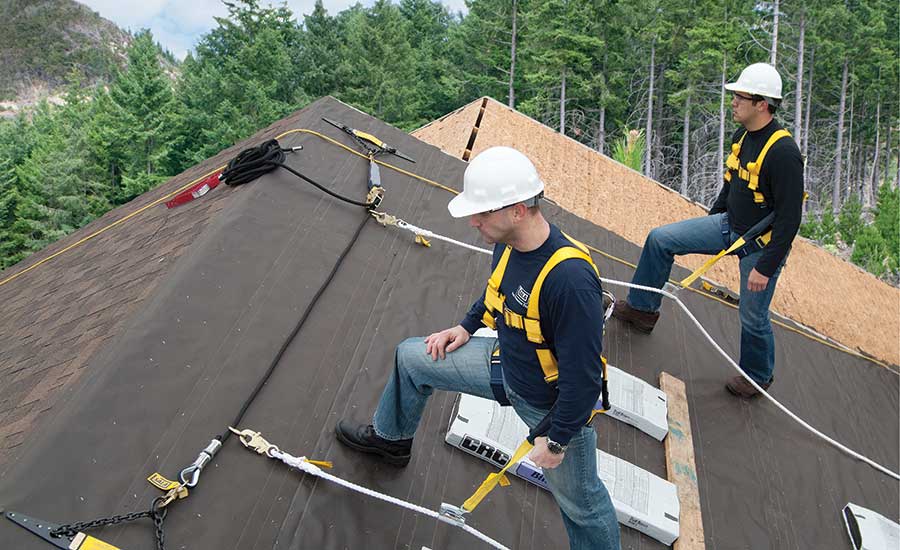Roofing projects are a common necessity for homeowners, whether it’s repairs, inspections, or replacements. While maintaining your roof is crucial, it’s equally important to prioritize safety during these tasks. Residential roofing can be hazardous, and accidents can lead to severe injuries or even fatalities. In this blog, we’ll discuss essential residential roofing safety tips to ensure you and your loved ones stay safe while maintaining your home.
1. Leave It to the Professionals
Perhaps the most crucial safety tip is to avoid DIY roofing projects, especially if you’re not experienced. Roofing requires specific skills, tools, and knowledge that professional roofers possess. Attempting to do it yourself can lead to accidents and subpar work that may cost more in the long run.
2. Wear Appropriate Safety Gear
For those who do engage in roofing work, wearing the right safety gear is non-negotiable. This includes:
- Non-slip, rubber-soled shoes: They provide grip and stability on the roof’s surface.
- Safety harnesses and fall protection equipment: Always use a safety harness, especially on steep-slope roofs.
- Gloves: Protect your hands from sharp roofing materials.
- Safety glasses or goggles:shield your eyes from debris and prevent accidents.
- Hard hat: Guard your head against falling objects or accidental bumps.
3. Inspect the Roof Beforehand
Before stepping onto your roof, conduct a thorough inspection to identify potential hazards. Look for loose shingles, weak spots, and debris that may make the roof unstable. Address these issues before starting any work.
4. Use Ladders Safely
When using a ladder to access the roof, ensure it’s stable and positioned correctly. Follow these ladder safety guidelines:
- Place the ladder on level ground and secure it to prevent slipping.
- Extend the ladder at least three feet above the roof’s edge to provide a stable handhold when transitioning.
- Maintain the “3-point contact” rule: Always have two hands and one foot, or two feet and one hand, on the ladder while climbing.
5. Be Mindful of Weather Conditions
Roofing work should be avoided during adverse weather conditions like rain, snow, or strong winds. Wet or icy surfaces can be dangerously slippery, making falls more likely. Plan your roofing tasks on dry, calm days for optimal safety.
6. Work with a Buddy
Whenever possible, have a buddy present when working on the roof. They can provide assistance, keep an eye out for potential dangers, and be ready to call for help in case of an emergency.
7. Know Your Limits
If you’re not comfortable with heights or feel unsure about the roofing task at hand, it’s best to hire a professional. Overestimating your abilities can lead to accidents. Always prioritize your safety over any potential cost savings.
8. Beware of Power Lines
If your roofing project involves electrical work, stay clear of power lines. Contact your utility company to temporarily shut off the power if necessary. Never touch power lines or attempt electrical work without the proper qualifications.
9. Handle Tools Safely
Residential roofing often involves the use of tools like nail guns, saws, and hammers. Handle these tools with care and follow the safety instructions provided by the manufacturer. Keep your tools organized and secure to prevent accidents.
10. Be Cautious Around Skylights and Vents
Skylights and roof vents are potential weak spots on a roof. Exercise caution when working near them to avoid accidental falls. If you need to access or work around these areas, ensure they are properly secured.
11. Stay Hydrated and Take Breaks
Roofing work can be physically demanding. Stay hydrated, take regular breaks, and avoid working in extreme heat or cold for prolonged periods. Overexertion can lead to fatigue and impair your judgment, increasing the risk of accidents.
12. Know What to Do in Case of an Accident
Despite all precautions, accidents can happen. It’s essential to know what to do in case of an emergency. Have a first-aid kit on hand, know how to administer basic first aid, and have a plan for getting help quickly if needed.
Conclusion
Residential roofing is a vital aspect of home maintenance, but it should never come at the expense of your safety. Prioritizing safety during roofing projects, whether by hiring professionals or adhering to safety guidelines, is crucial. Remember that a well-maintained roof is essential, but nothing is more valuable than your well-being. By following these residential roofing safety tips, you can ensure that your roofing projects are completed safely and efficiently, protecting both you and your home.


